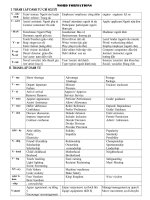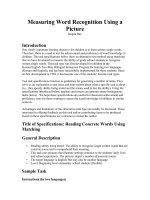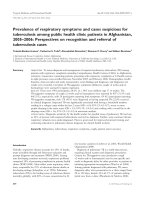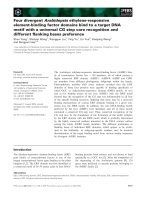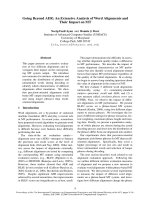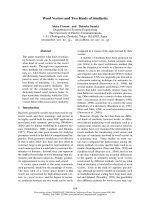Word recognition and fluency
Bạn đang xem bản rút gọn của tài liệu. Xem và tải ngay bản đầy đủ của tài liệu tại đây (17.67 MB, 414 trang )
The Meadows Center
FOR P R E V E N T I NG E DUC AT IONA L R I SK
The Meadows Center
FOR P R E V E N T I NG E DUC AT IONA L R I SK
Developed with funds from
The Meadows
Center
The FMeadows
Foundation
OR P R E V E N T I NG E DUC AT IONA L R I SK
Word Recognition
and Fluency
Effective Upper-Elementary
Interventions for Students
With Reading Difficulties
by Jeanne Wanzek, Anita Harbor, and Sharon Vaughn
© 2010 The Meadows Center for Preventing Educational Risk,
the University of Texas at Austin
Center
TIONAL R ISK
www.meadowscenter.org
The Meadows Center
These materials are copyrighted © by and are the property of The Meadows Center
F O R P R Eat
V The
E N T IUniversity
N G E D U C Aof
T ITexas
O N A Lat
R Austin
ISK
for Preventing Educational Risk (MCPER)
and may
not be reproduced or distributed without express written permission from MCPER,
except under the following conditions:
1. any portion reproduced or distributed will be used exclusively for nonprofit
educational purposes;
2. any portion reproduced must remain unedited, unaltered, and unchanged in
any way;
3. no monetary charge is made for the reproduced materials, any document
containing them, or any activity at which they are distributed; however, a
reasonable charge to cover only the cost of reproduction and distribution may
be charged.
To obtain a license to use the materials in a manner not specified above, contact
The Meadows Center
FOR P R E V E N T I NG E DUC AT IONA L R I SK
Acknowledgments
The authors gratefully acknowledge the support of the following individuals and agencies for
their contributions to the studies and the manual.
The Meadows Foundation
Wilson Historic District
3003 Swiss Avenue
Dallas, TX 75204
The Meadows Center for Preventing Educational Risk
College of Education
The University of Texas at Austin
www.meadowscenter.org
Manuel J. Justiz, Dean
Sharon Vaughn, Executive Director
Research and Development Team
Deborah Boswell
Julie Graham
Anita Harbor
Anna K. Harris
Janine Langley
Rachel Lee
Heather Leonard
Sharon Vaughn
Jeanne Wanzek
Design and Editing
Matthew Slater
Carlos Treviño
Elana Wakeman
Contents
LESSON PLANS........................................................................................................................1
Introduction.....................................................................................................................................................................................3
Irregular Words Lesson..............................................................................................................................................................7
Lesson 1: Short Vowels...........................................................................................................................................................11
Lesson 2: Consonant-Vowel-Consonant Words......................................................................................................27
Lesson 3: Consonant Digraphs..........................................................................................................................................43
Lesson 4: Consonant Blends...............................................................................................................................................61
Lesson 5: r-Controlled Syllables........................................................................................................................................77
Lesson 6: Vowel-Consonant-e Syllables.......................................................................................................................95
Lesson 7: Letter Combinations.......................................................................................................................................117
Lesson 8: Open Syllables....................................................................................................................................................139
Lesson 9: Contractions.........................................................................................................................................................155
Lesson 10: Compound Words.........................................................................................................................................171
Lesson 11: Affixes With Unchanging Base Words...............................................................................................187
Lesson 12: ed Suffix With Unchanging Base Words...........................................................................................203
Lesson 13: Multisyllabic Word Reading.....................................................................................................................221
Lesson 14: Consonant-le Syllables................................................................................................................................243
Lesson 15: Soft g and Soft c..............................................................................................................................................265
Lesson 16: Adding Vowel Suffixes to CVC and Silent e Base Words........................................................287
Lesson 17: Adding Suffixes That Change Base Words’ Final y to i..............................................................313
APPENDIX............................................................................................................................ 335
Word Lists....................................................................................................................................................................................335
Academic Word Lists............................................................................................................................................................377
Resources, Glossary, and References..........................................................................................................................395
Blackline masters of lesson materials are available on the accompanying CD.
Word Recognition and Fluency: Effective Upper-Elementary Interventions for Students With Reading Difficulties
© 2010 The Meadows Center for Preventing Educational Risk, the University of Texas at Austin
WORD
RECOGNITION
AND FLUENCY
LESSON PLANS
Word Recognition and Fluency: Effective Upper-Elementary Interventions for Students With Reading Difficulties
© 2010 The Meadows Center for Preventing Educational Risk, the University of Texas at Austin
Word Recognition and Fluency: Effective Upper-Elementary Interventions for Students With Reading Difficulties
© 2010 The Meadows Center for Preventing Educational Risk, the University of Texas at Austin
Lesson Plans
Introduction | 3
Introduction
LESSON PROGRESSION
This resource book presents lessons that teach word recognition skills and strategies in a
systematic and cumulative way. Students build knowledge as lessons progress from easy to
difficult skills. Previously learned skills are reviewed, linked to newly presented content, and
included in the new lesson’s practice activities. The example words in practice activities were
selected to be useful in students’ school and home lives. As lessons progress, students learn the
skills and strategies to read an increasing number and variety of words—thus allowing students
to read more sentences and longer texts. A lesson structure is also presented for teaching irregular
words. This lesson structure can be used daily from the beginning to teach new irregular words
for student reading.
Lessons 1–9 are for students who have not yet mastered basic sounds and using these sounds to
blend words. These lessons are structured around one-syllable words. The first lesson template
begins with a review of consonant sounds and moves on to introducing short vowel sounds.
The lesson template can be used on different days to introduce each of the short vowel sounds,
according to student needs. In subsequent lessons, students learn to blend sounds to form
consonant-vowel-consonant (CVC) words such as mat, sip, and let. Next are lessons that introduce
the more advanced sounds of consonant digraphs, consonant blends, and r-controlled sounds.
Long vowel sounds are introduced with the vowel-consonant-e (VCe) syllable. Then, two more
syllable types with long vowel sounds are introduced: letter combinations (key, grown, main)
and open syllables (hi, re-, flu). In each of these lessons, students build on their understanding
of blending sounds in one-syllable words. Again, the lessons often provide a structure for
introducing multiple sounds that will be used over several days or weeks, according to the
number of sounds that need to be introduced and student needs.
Lessons 10–17 teach skills and strategies for reading multisyllabic words, beginning with
compound words, proceeding to words with affixes, and then moving to a multisyllabic word
reading strategy for decoding long words. Advanced concepts are taught next, including the
consonant-le syllable (candle, table), soft g and c (gem, cent), and base words that change when a
suffix is added (plan-planning; happy-happiness, make-making).
Word Recognition and Fluency: Effective Upper-Elementary Interventions for Students With Reading Difficulties
© 2010 The Meadows Center for Preventing Educational Risk, the University of Texas at Austin
4 | Introduction
Lesson Plans
It is not necessary or realistic for every group of students to begin with Lesson 1 and proceed
through one lesson each day. You will find that students move quickly through certain lessons
and that students will require more time and practice before mastering the material in other
lessons. Some lessons are used several times to introduce different, related sounds. For example,
the lesson for letter combinations is used when introducing any of the 18 letter combinations.
When the same lesson is used more than once, multiple guided practice and independent
activities are provided to allow for varied practice. Use a pace that best meets your students’
needs. Finally, remember that the lessons are cumulative, building upon previous lessons, so it is
optimal to teach them in the order in which they are presented.
LESSONS OVERVIEW
The lessons teach skills explicitly and in a consistent format. Each lesson consists of lesson
objectives, a list of necessary materials, lesson tips, a review activity, activities that provide
scaffolded instruction, ideas for monitoring learning, and information about generalization.
•
Objectives. What the student will be able to do as a result of instruction.
•
Materials. A list of the materials necessary for each lesson. Blackline masters of many
materials, including student worksheets, letter cards, word cards, templates, and game
boards, are found on the accompanying CD.
•
Tips. Ideas and information to enhance instruction.
•
Daily Review. A quick review of the previous lesson.
•
Opening. A brief description of what students will learn, why it is important, and how it
connects to, or is different from, previously taught content.
•
Lesson Activities. Introduce students to skills and strategies through three levels of
scaffolded instruction:
•
Model and Teach. The teacher explicitly explains, teaches, demonstrates, and models
the new skill or strategy.
•
Guided Practice. Once students are familiar with the skill or strategy, the teacher
provides guidance as students practice applying it to reading words.
•
Independent Practice. As students gain proficiency, they apply the skill to reading
words and connected text independently while the teacher provides assistance.
Word Recognition and Fluency: Effective Upper-Elementary Interventions for Students With Reading Difficulties
© 2010 The Meadows Center for Preventing Educational Risk, the University of Texas at Austin
Lesson Plans
Introduction | 5
Within each level of instruction, teachers should monitor students’ understanding and be
prepared to reteach or provide additional modeling or practice before moving on to the
next level.
Decoding (reading) and encoding (spelling) activities are included for each level of
instruction. When introducing a new sound, skill, or strategy, use all the decoding and
encoding activities in the model and teach level. When practicing the sound, skill, or
strategy, choose at least one decoding and one encoding activity from the guided
practice and independent practice levels. A variety of guided practice and independent
practice activities provide options when the same lesson structure is used to teach new
sounds or when reteaching is necessary. These activities incorporate hands-on worksheets,
games, and manipulatives that provide meaningful, relevant opportunities to practice
and apply the sound, skill, or strategy. Each activity begins with a description of the task,
followed by a sample dialogue. The dialogue is an example of the type of wording to use
while teaching, but it is not a script. It is important to teach the lessons using your unique
style.
Tips and adaptations follow certain activities, including ideas for error correction, common
trouble spots, scaffolding tips, and suggestions on different ways to implement the
activity.
•
Monitor Learning. Provides lesson-specific areas to check students’ understanding.
•
Generalization. A description of how the knowledge learned applies to other areas at
school and at home.
•
Lesson Materials. Thumbnail images of lesson materials follow each lesson. Electronic
files of these materials are found on the accompanying CD.
Word Recognition and Fluency: Effective Upper-Elementary Interventions for Students With Reading Difficulties
© 2010 The Meadows Center for Preventing Educational Risk, the University of Texas at Austin
6 | Introduction
Lesson Plans
Word Recognition and Fluency: Effective Upper-Elementary Interventions for Students With Reading Difficulties
© 2010 The Meadows Center for Preventing Educational Risk, the University of Texas at Austin
Irregular Words Lesson | 7
Lesson Plans
Irregular Words
Lesson Plan
OBJECTIVE
Students will read and spell words with irregular sound-spelling patterns.
RATIONALE
Irregular words do not fit the typical letter-sound correspondence that students have learned.
Put another way, they are “rule-breakers”. Certain high-frequency words, such as said, was, do, to,
what, and they, are irregular. Words that include exceptions to syllable-type conventions are also
considered to be irregular. For example, the a in have makes its short vowel sound, rather than the
long vowel sound that is typical of vowel-consonant-e syllables.
Some irregular words should be memorized, becoming what is known as “sight words”—words
that are instantly recognized as a whole. Some words may be considered irregular because a
student has not yet learned the sound of a particular letter pattern. Little would be an irregular
word for students who have not yet learned about consonant-le syllables.
Choose irregular words that appear frequently in students’ reading and writing. Such words are
more useful to students. If a student can already read an irregular word, it is not necessary to
explicitly teach it.
TEACHING NEW WORDS
Make an index card for each word you introduce. These cards can be used for review, reteaching,
or a word wall. Present the first card and say the word. Have students say the word, spell it, and
then say the word again.
Teacher:
This word is where. What is the word?
Students:
where
Teacher:
Spell where.
Word Recognition and Fluency: Effective Upper-Elementary Interventions for Students With Reading Difficulties
© 2010 The Meadows Center for Preventing Educational Risk, the University of Texas at Austin
8 | Irregular Words Lesson
Lesson Plans
[Point to each letter as students spell the word.]
Students:
w-h-e-r-e
Teacher:
Say the word again.
Students:
where
Introduce one to seven words at a time, depending on student mastery. Provide students with
multiple opportunities to read each word as it is introduced. Do not introduce a new word if
students have not mastered previously introduced words.
REVIEWING WORDS
After new words have been introduced, review five to seven previously learned words in random
order. Provide multiple opportunities for students to read previously taught words—particularly
those with which students struggle.
Present the word cards and have students say the words. Correct errors by saying the word and
then having the student say the word, spell the word, and say the word again. Put the cards for
words that students read incorrectly in a separate pile for reteaching during the next lesson.
Teacher:
Let’s review some words. When I show you a word card, say the word.
[Show the first word: earth.]
Students:
earth
[Show the next word: chief.]
Students:
/chīf/
Teacher:
The word is chief. What word?
Students:
chief
Teacher:
Say it, spell it, say it.
Students:
Chief, c-h-i-e-f, chief.
[Present the next words.]
Word Recognition and Fluency: Effective Upper-Elementary Interventions for Students With Reading Difficulties
© 2010 The Meadows Center for Preventing Educational Risk, the University of Texas at Austin
Lesson Plans
Irregular Words Lesson | 9
MONITOR LEARNING
Reteach words that were misread, providing additional opportunities for students to read the
words.
Word Recognition and Fluency: Effective Upper-Elementary Interventions for Students With Reading Difficulties
© 2010 The Meadows Center for Preventing Educational Risk, the University of Texas at Austin
10 | Irregular Words Lesson
Lesson Plans
Word Recognition and Fluency: Effective Upper-Elementary Interventions for Students With Reading Difficulties
© 2010 The Meadows Center for Preventing Educational Risk, the University of Texas at Austin
Lesson 1 | 11
Lesson Plans
Short Vowels
Lesson 1
OBJECTIVES
•
Students will say the short vowel sounds that correspond to specific vowels.
•
Students will identify the vowels associated with specific short vowel sounds.
MATERIALS
•
Lesson 1 letter cards (one set each for teacher and students)*
•
Letter-sound practice worksheet*
•
Colored pencils (blue, green, red)
•
Picture worksheet*
•
Timer
•
Board and markers or chalk for teacher
•
Personal whiteboards and markers for students
•
Notebook paper
*Blackline master available on CD.
TIPS
•
Use key words when introducing short vowel sounds—for example, e, egg, /e/. The
following key words are suggested: a–apple, e–egg, i–igloo, o–octopus, and u–up.
•
Encourage students to refer back to the key word as a clue to the sound of the letter.
•
Provide sufficient wait time for student responses. Establish a gesture or cue phrase (e.g.,
“Ready? Go.”) for choral responses.
•
Include previously taught sounds in the daily review and lesson activities.
Word Recognition and Fluency: Effective Upper-Elementary Interventions for Students With Reading Difficulties
© 2010 The Meadows Center for Preventing Educational Risk, the University of Texas at Austin
12 | Lesson 1
Lesson Plans
•
Include activities that provide students with practice discriminating among previously
taught vowel sounds.
•
Do not teach all the short vowel sounds and key words in one lesson.
•
The following is the suggested order of instruction: a, i, o, u, e.
•
Do not include words that have not been previously taught.
•
Provide direct feedback on student performance.
DAILY REVIEW
CONSONANT SOUNDS
Review by asking students to produce sounds for specific consonants. Ask for individual and
group responses, and randomize the order in which you point to the letters.
Teacher:
Today, we will review consonant sounds. I will point to a letter, and you will tell
me the sound it makes. Be alert, because I will jump around in the alphabet.
Remember, the cue that it’s time for everyone to repeat is an open palm, like this.
[Demonstrate.]
When I say your name, answer aloud. Everyone else, answer silently. Let’s try it.
[Point to m and gesture with an open palm.]
Students:
/m/
Teacher:
That’s correct, /m/.
[Point to t and gesture.]
Students:
/tuh/
Teacher:
Some people said /tuh/. Remember, we have to clip the sound for t because it
can’t be extended. T makes the sound /t/.
[Point to t again and gesture.]
Students:
/t/
Word Recognition and Fluency: Effective Upper-Elementary Interventions for Students With Reading Difficulties
© 2010 The Meadows Center for Preventing Educational Risk, the University of Texas at Austin
Lesson 1 | 13
Lesson Plans
Teacher:
Yes, /t/. Excellent clipping!
[Point to b.]
LaToya, what sound?
LaToya:
/b/
Teacher:
Correct, LaToya, and everyone else did a fabulous job answering silently. Now, we
will speed things up!
[Point to l.]
Eli, what sound?
Eli:
/l/
[Point to k and gesture.]
Students:
/k/
Teacher:
Raise your hand if you can tell me another letter that makes the /k/ sound.
Carla:
C makes the /k/ sound.
Teacher:
That’s right. The letter c also says /k/.
[Point to n and gesture.]
Students:
/n/
Continue until you have reviewed all the desired sounds.
OPENING
For the purposes of illustration, this lesson plan cover all of the vowel sounds. In practice, we
recommend introducing vowels one or two at a time, intermixed with consonant instruction. Be
sure to separate initial instruction in the sounds of e and i to avoid confusion.
Teacher:
Let’s learn the short vowel sounds. Remember that the vowels are a, e, i, o, and u. It
is important to learn vowel sounds because, in English, every word has at least one
vowel. To become good readers, you need to know what sounds vowels make.
Word Recognition and Fluency: Effective Upper-Elementary Interventions for Students With Reading Difficulties
© 2010 The Meadows Center for Preventing Educational Risk, the University of Texas at Austin
14 | Lesson 1
Lesson Plans
MODEL AND TEACH: ACTIVITY 1
LETTER-SOUND CORRESPONDENCE
PREPARATION FOR DECODING AND ENCODING
Teach students letter-sound correspondence, using the following general sequence:
1. Show students a letter and introduce its short vowel sound and key word.
2. Say several words that contain the short vowel sound and have students repeat the words.
3. Read a word and have students identify whether it has the target sound.
[Show the letter a or write it on the board.]
Teacher:
The short vowel sound for the letter a is /aaa/...
[Stretch out the sound.]
...as in the word apple. We will use the word apple as the key word for /a/. We will
say, “a, apple, /a/” to remind us of the letter name, the key word, and the short
vowel sound: a, apple, /a/. Repeat, please.
Students:
A, apple, /a/.
Teacher:
Say it one more time.
Students:
A, apple, /a/.
Teacher:
The sound for a is /aaa/. Say the sound.
Students:
/aaa/
Teacher:
I will say some words with /a/. Please repeat after me.
[Present these words orally to help students focus on the /a/ sound. Stretch
out the /a/ into /aaa/ when presenting.]
Teacher:
/aaafter/
[Gesture with an open palm now and after every word presented.]
Students:
/aaafter/
Word Recognition and Fluency: Effective Upper-Elementary Interventions for Students With Reading Difficulties
© 2010 The Meadows Center for Preventing Educational Risk, the University of Texas at Austin
Lesson 1 | 15
Lesson Plans
Teacher:
/aaad/
Students:
/aaad/
Teacher:
/saaad/
Students:
/saaad/
Teacher:
What is the short vowel sound for a?
[Point to a on the board.]
Students:
/a/
Teacher:
A, apple, /a/.
Students:
A, apple, /a/.
Teacher:
Now, listen for /a/ in words that I say. Some will have /a/, and some will not. If the
word has /a/, show me a thumbs-up. If it does not have /a/, show me a thumbsdown. Remember to wait for my hand sign. Hat.
[Gesture. Students show thumbs-up.]
Teacher:
Good job. You all showed me a thumbs-up because hat has the /a/ sound. Admit.
[Gesture. Students show thumbs-up.]
Continue with other words; for example, mad, lip, happy, nap, stop, dad, etc. After each word,
gesture for students to show you a thumbs-up or thumbs-down.
ERROR CORRECTION
Use guiding questions to correct students who make an error, such as in the following example
script.
Teacher:
What sound are you listening for?
Student:
/a/
Teacher:
Do you hear /a/ in lip?
Word Recognition and Fluency: Effective Upper-Elementary Interventions for Students With Reading Difficulties
© 2010 The Meadows Center for Preventing Educational Risk, the University of Texas at Austin
16 | Lesson 1
Lesson Plans
TIPS
•
Create a poster for each vowel, showing its key word and a picture of the key word (e.g.,
the word apple and a picture of an apple for a).
•
When introducing vowel sounds, scaffold by stretching out the sounds.
•
Keep a brisk pace.
GUIDED PRACTICE: ACTIVITY 1
WHAT SOUND?
DECODING
Spread out letter cards in front of students. Point to a letter. Have students say its sound. Focus on
the sounds you are teaching, but include previously introduced sounds as well.
Teacher:
I will point to a letter. When I give you the cue, everyone say the sound.
[Point to a and gesture with an open palm.]
Students:
/a/
[Point to f and gesture.]
Students:
/f/
[Point to b.]
Eli?
Eli:
/b/
ERROR CORRECTION
Tell students who make an error the correct sound. Then point to the letter again and have
students say the sound.
TIPS
•
Keep a brisk pace.
•
Point to target sounds at least twice for extra practice.
Word Recognition and Fluency: Effective Upper-Elementary Interventions for Students With Reading Difficulties
© 2010 The Meadows Center for Preventing Educational Risk, the University of Texas at Austin
Lesson 1 | 17
Lesson Plans
GUIDED PRACTICE: ACTIVITY 2
FLASHCARD DRILL
DECODING
Display a letter card and, on your cue, have students say the sound. The cue is important because
it gives students time to think and prevents them from blurting out or guessing. Randomly elicit
group and individual responses.
Teacher:
I will show one card at a time. Say the sound in your head, and when I give the
hand sign, say the sound aloud. Even if you know the sound right away, wait for
the sign. Let’s practice.
[Turn over the top card, m in this example, and gesture.]
Students:
/m/
Nicely done! Pay close attention because sometimes, I might say a person’s name.
That person should say the sound aloud while everyone else reads silently. Ready?
[Turn over next card, p in this example.]
Eli?
Eli:
/p/
Teacher:
Great. Did everyone notice how Eli clipped the sound? He said /p/, not /puh/.
Good work, Eli. Let’s speed it up quite a bit now.
[Show next card, i, and gesture.]
Students:
/i/
Continue turning over cards. As students gain proficiency, use a more rapid pace.
ERROR CORRECTION
Tell students who make an error the key word (e.g., o, octopus, /o/). Have the students repeat.
TIP
Use extra cards of target sounds, so students have multiple opportunities to practice the sounds.
Word Recognition and Fluency: Effective Upper-Elementary Interventions for Students With Reading Difficulties
© 2010 The Meadows Center for Preventing Educational Risk, the University of Texas at Austin
18 | Lesson 1
Lesson Plans
GUIDED PRACTICE: ACTIVITY 3
WHAT SAYS…
ENCODING
Spread out letter cards in front of students. Follow the steps below. Focus on the sounds being
taught, but include previously introduced sounds as well.
1. Dictate a sound.
2. Have a student repeat the sound (listen for accuracy).
3. Have the student point to the corresponding letter card.
Teacher:
I will say a sound. You will then repeat the sound and point to the letter card that
makes the sound. What says /a/?
Students:
/a/
[Students point to a.]
Teacher:
What says /f/?
Students:
/f/
[Students point to f.]
Teacher:
Nice job. /b/?
[Students point to b.]
Continue dictating sounds. Give students plenty of opportunities with the target sound.
ERROR CORRECTION
Correct students who point to the incorrect card, such as in the following example script.
Teacher:
F makes the /f/ sound. What says /f/?
[Point to the letter as you say /f/.]
ADAPTATION
Instead of letter cards, use a form with letters printed on it.
Word Recognition and Fluency: Effective Upper-Elementary Interventions for Students With Reading Difficulties
© 2010 The Meadows Center for Preventing Educational Risk, the University of Texas at Austin
Lesson 1 | 19
Lesson Plans
GUIDED PRACTICE: ACTIVITY 4
WHITEBOARD DICTATION
ENCODING
Dictate sounds and have students write the corresponding letters on a whiteboard. Dictate
sounds either in isolation (e.g., /o/), or as part of a word (e.g., “the middle sound in the word log”).
Focus on the target sounds and trouble spots, but include previously taught sounds.
Teacher:
I will dictate a sound. You will repeat the sound and then write the letter that
makes the sound on your whiteboard. After you write the sound, hold your
whiteboard up so I can see it. /e/
[Gesture so that students repeat the sound.]
Students:
/e/
[Students write on boards and hold them up.]
Teacher:
Nice job, everyone. Next sound: the first sound in the word hum. Say the word
hum.
Students:
hum
Teacher:
Write the letter that makes the first sound in hum.
Continue, providing students with many opportunities to practice the target sounds.
ERROR CORRECTION
If students make an error with an individually dictated sound, model the correct response and
have the students repeat, such as in the following example script.
Teacher:
N makes the /n/ sound. What says /n/?
Students:
n
If the error is with a sound within a word, use language similar to the following example script.
Teacher:
H makes the first sound in hum. What letter?
Students:
h
Word Recognition and Fluency: Effective Upper-Elementary Interventions for Students With Reading Difficulties
© 2010 The Meadows Center for Preventing Educational Risk, the University of Texas at Austin
20 | Lesson 1
Lesson Plans
INDEPENDENT PRACTICE: ACTIVITY 1
BEAT THE CLOCK: LETTER SOUNDS
DECODING
This activity increases automaticity in letter-sound correspondence. Students read the lettersound practice worksheet three times, with the goal of increasing speed and accuracy with each
reading. The three rounds are referred to as the cold round, warm round, and hot round. Each
round consists of the following sequence:
1. Student A is the Reader; Student B is the Listener.
2. The Reader says the sounds on the sheet (going from left to right, top to bottom) as
quickly and correctly as possible for 30 seconds.
3. The Listener monitors, marking incorrect responses on the sheet with a blue pencil for the
cold round, green pencil for the warm round, and red pencil for the hot round.
4. At the end of the 30 seconds, the Listener circles the last response and calculates the
number of correct responses.
5. The Listener gives the Reader positive and corrective feedback.
6. Switch roles: Student A becomes the Listener, and Student B becomes the Reader.
7. Follow steps 2–5 again.
Prior to giving directions, distribute the letter-sound practice worksheet, divide students into pairs
and designate a person in each pair as Student A or Student B.
Teacher:
This activity will help you say sounds quickly and correctly. It’s fun because you
race against yourself. There are many steps; pay attention, so that we can go
quickly. Each of you has a letter-sound practice worksheet and colored pencils.
Write your name on the worksheet.
Exchange sheets with your partner. Yes, that means the paper in front of you will
have your partner’s name on it.
If you are Student A, raise your hand.
Student As, you are Readers, for now. You may put your hands down.
If you are Student B, raise your hand.
Word Recognition and Fluency: Effective Upper-Elementary Interventions for Students With Reading Difficulties
© 2010 The Meadows Center for Preventing Educational Risk, the University of Texas at Austin
Lesson 1 | 21
Lesson Plans
Student Bs, you are Listeners, for now. Please put your hands down.
When I start the timer, Readers will say the sounds for the letters on the sheet as
quickly and correctly as possible. Read left to right, top to bottom, just like reading
a book. Use your finger to keep track of where you are. If you get to the bottom of
the page, go back to the beginning and start again. When the timer rings, I will say,
“Stop,” and the Reader will stop reading.
Let’s check your listening. Who can tell me what a Reader does? LaToya?
LaToya:
When the timer starts, the Reader says the sounds as fast as she can until you say,
“Stop.”
Teacher:
What do you do if you get to the bottom before I say stop? Andre?
Andre:
You start again from the beginning.
Teacher:
Excellent! Listeners, you will follow along with the Reader. If the Reader makes
a mistake, draw a line through that letter on the sheet in front of you. You also
should use your finger to keep track.
When I say, “Stop,” the Listener circles the last response, counts the total number of
correct responses, and writes it at the top of the sheet.
The Listener gives the Reader feedback, just like a teacher. The Listener gives
positive feedback, like, “You did a great job on the vowels” or “You were faster that
time.” Also like a teacher, the Listener gives corrective feedback on items the Reader
missed, like “This says /m/, but you said /n/” or “The vowel sound for i is /i/.”
Let’s practice. Andre, what might you say to encourage your partner after they
finish the letter sheet?
[Andre gives an example of his response.]
Eli, if your partner misses a sound, what might you say to help them?
[Eli gives an example of his response.]
OK, who can tell me two parts of the Listener’s job? Carla?
Carla:
The Listener marks what the Reader got wrong and then adds up how many he
got right and writes it on the paper.
Word Recognition and Fluency: Effective Upper-Elementary Interventions for Students With Reading Difficulties
© 2010 The Meadows Center for Preventing Educational Risk, the University of Texas at Austin

